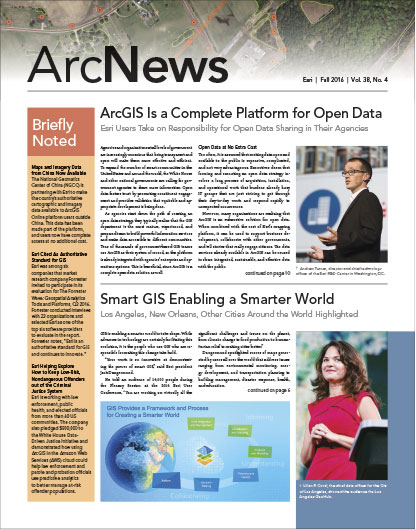When complex emergencies like Typhoon Haiyan occur, Esri’s Disaster Relief Program (DRP) provides direct support to the organizations and agencies charged with handling these exceptional situations.
The impetus to create the DRP came on September 11, 2001, when terrorists commandeered two airliners and destroyed the World Trade Center’s twin towers. New York City’s state-of-the-art Emergency Operations Center (EOC) was also wiped out in the ensuing inferno. Computers, data, software—the EOC’s entire infrastructure, including the ArcGIS software it relied on for emergency response and recovery—were lost in an instant.
Esri and other organizations quickly responded to the city’s call for help. A temporary EOC was set up on Pier 92 on the Hudson River in Manhattan, and regional Esri staff members began providing critical software licenses, personnel, and data to support New York’s mapping needs. At Esri’s headquarters in Redlands, California, the technical support staff worked around the clock to fulfill the growing number of mapping requests.
“Following 9/11, we immediately realized that the potential for disaster was ever present and GIS technology could play a fundamental part in the response and recovery efforts,” said Russ Johnson, Esri’s director of global public safety business development. “We established a formal program, and the resultant DRP has been very successful during the past 15 years. To date, we have responded to nearly 1,950 requests for assistance.”
The DRP has provided support for a number of recent, high-profile emergencies, including the downing of Malaysia Airlines flight MH17 over Ukraine in July 2014. The attack took place on the final day of the Esri User Conference in San Diego, California, and conference attendees from Malaysia’s Department of Survey and Mapping quickly joined Esri specialists and key partners to form a team of multidisciplinary geospatial experts. They gathered in a meeting room at a local hotel where the DRP had set up a temporary operations center. The assembled team rapidly established a website that provided the Malaysian Armed Forces with access to a common operating picture that included detailed maps and demographics for Ukraine.
Among other requests for assistance, the DRP provided the Armed Forces of the Philippines (AFP) with mapping support for their recovery efforts from the destruction caused by Typhoon Haiyan in 2013. Later, the team donated an ArcGIS Online organizational license to the AFP to assist in the agency’s extensive security preparations for the APEC Economic Leaders’ Meeting in Manila in 2015.
“We realized that the DRP was receiving an increasing number of requests to support large, high-profile events like the AELM,” said Chris McIntosh, director of public safety industries at Esri. “So we added a special events component to it and launched the Special Events Management Program (SEMP) in 2014.”
This prompted a reorganization of Esri’s response programs. Both the DRP and SEMP now fall under the newly established Esri Public Safety Assistance Program (EPSAP). The EPSAP was recently on alert to provide mapping support for the 2016 Democratic and Republican National Conventions in the United States.
“The mission of Esri’s response programs is to reinforce its reputation as a good corporate citizen by providing software and support to organizations and agencies impacted by complex emergencies and large-scale special events,” said McIntosh. “Esri staff members are available at all times to respond to an emergency whenever or wherever it happens.”
How It Works
To receive assistance, an agency or organization first needs to fill out a request form on the DRP website. The DRP team then receives an automatic notification that a request has been filed.
“[We] are on call 24/7/365 to monitor, review, and process requests to support emergencies or events anywhere in the world,” said Brenda Martinez, public safety sector marketing specialist at Esri. “After we receive the request, it is reviewed to determine the specific need and then sent to the appropriate Esri staff members or departments for processing.”
For more information about the Esri Disaster Response Program or to request assistance, visit the DRP website. It contains resources such as public information maps, examples of disaster response and recovery methodology, web map templates, how-to guides, live-feed data, social media feeds, case studies, and videos.

